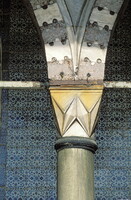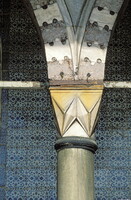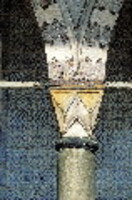| dc.coverage.spatial | Site: Istanbul, Marmara, Turkey | en_US |
| dc.coverage.temporal | ca. 1453-1853 (inclusive) | en_US |
| dc.creator | unknown (Islamic) | en_US |
| dc.date | 1453-1853 | en_US |
| dc.date.accessioned | 2013-03-27T16:30:48Z | |
| dc.date.available | 2013-03-27T16:30:48Z | |
| dc.date.issued | 1453-1853 | en_US |
| dc.identifier | 202958 | en_US |
| dc.identifier.other | archrefid: 1019 | en_US |
| dc.identifier.uri | http://hdl.handle.net/1721.3/110913 | |
| dc.description | Baghdad Kiosk, the southwest elevation, column detail; The first major additions to the palace in the 17th century occurred during the reign of the bellicose Murad IV (reigned 1623-1640), who built in the Fourth Court the lovely Revan and Baghdad kiosks to commemorate his victories at Erevan (1635-1636) and Baghdad (1638-1639). Based on the classical type of four-iwan plan, they have projecting eaves, domed central spaces and interiors with recessed cupboards and woodwork inlaid with mother-of-pearl. They typify Islamic and Ottoman palace structures. Their decoration in blue-and-white tiles deliberately patterned after those of a century earlier are self-conscious attempts to duplicate the glories of an earlier age. The nearby Circumcision Room (Sunnet Odasi), built in 1648 by Ibrahim (reigned 1640-1648), is an altogether simpler structure than Murad's two kiosks, but it is largely decorated on the exterior with tiles that once graced ceremonial buildings of Suleyman. Although it is not certain when these recycled tiles were added to the Circumcision Room, it is highly probable that these prototypes for the decoration of Murad's kiosks were moved to their present location ca. 1648 as part of the same reverence and nostalgia for the art of the age of Suleyman. Ibrahim also erected the terrace that links the Circumcision Room with Murad's kiosks and the arcaded roof around the Chamber of the Holy Mantle. The pool and fountain in the Fourth Court (1729) were added during the reign of Ahmed III. In 1752 Mahmud I rebuilt the Kiosk of Mustafa Pasha in the Fourth Court: the interior contains a Rococo ceiling, but this unusually spare and open building, with its large windows derived from the wooden residences along the Bosporus, injects a refreshing and forward-looking architectural note. The last significant royal addition to the palace was the Kiosk of Abdulmecid (ca. 1840) constructed by Sarkis Balyan on a built-up terrace beyond the Conqueror's Kiosk, with the same sweeping view of the Bosporus and the Sea of Marmara. This building, in the eclectic Europeanized style popularized by the Balyan family in the 19th century, is simply another typical seaside palace; its location within the Topkapi complex was due primarily to the magnificent view rather than to old imperial associations. Source: Grove Art Online; http://www.groveart.com/ (accessed 1/29/2008) | en_US |
| dc.format.medium | stone; marble; Iznik tile | en_US |
| dc.rights | © Scott Gilchrist, Archivision, Inc. | en_US |
| dc.subject | architectural exteriors | en_US |
| dc.subject | decorative arts | en_US |
| dc.subject | rulers and leaders | en_US |
| dc.subject | Ottoman Empire and its heritage | en_US |
| dc.subject | Suleyman I, Sultan of the Turks, 1494 or 5-1566 | en_US |
| dc.subject | Ottoman (style) | en_US |
| dc.title | Topkapi Palace; Fourth Court | en_US |
| dc.type | image | en_US |
| dc.rights.access | Licensed for educational and research use by the MIT community only | en_US |
| dc.identifier.vendorcode | 1A3-I-T-TP-4-A8 | en_US |
| vra.culturalContext | Islamic Turkish | en_US |
| vra.technique | construction (assembling) | en_US |
| vra.worktype | royal palace | en_US |
| vra.worktype | historic site | en_US |
| dc.contributor.display | unknown (Islamic) | en_US |



